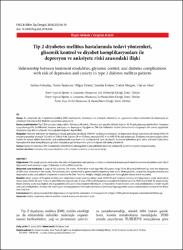Tip 2 diyabetes mellitus hastalarında tedavi yöntemleri, glisemik kontrol ve diyabet komplikasyonları ile depresyon ve anksiyete riski arasındaki ilişki
Künye
Gunalay S,Taskiran E, Demir B, Erdem S, Mergen H, Akar H. [Relationship between treatment modalities, glycemic control, and diabetes complications with risk of depression and anxiety in type 2 diabetes mellitus patients]. FNG & Bilim Tıp Dergisi 2016;2(1):16-19. doi: 10.5606/fng.btd.2016.004Özet
Amaç: Bu çalışmada tip 2 diyabetes mellitus (DM) hastalarında depresyon ve anksiyete risklerinin ve uygulanan tedavi yöntemleri ile depresyon ve anksiyete riski arasındaki ilişkinin saptanması amaçlandı.
Gereç ve yöntemler: Tip 2 DM tanısıyla takip edilen 128 hasta (58 erkek, 70 kadın; ort. yaş 60±10.8 yıl; dağılım 30-80 yıl) çalışmaya dahil edildi. Hastalara sosyodemografik özelliklerini, hastane anksiyete ve depresyon ölçeğini ve DM için kullanılan tedavi yöntemlerini sorgulayan bir anket uygulandı. Hastaların boy, kilo ve glikozile hemoglobin değerleri kaydedildi.
Bulgular: Hastane anksiyete ve depresyon ölçeği anksiyete alt ölçeği (HAD-A) ve hastane anksiyete ve depresyon ölçeği depresyon alt ölçeği (HAD-D) ortalama puanları sırasıyla 7.52±4.6 ve 7.98±4.4 idi. Toplam 39 ve 63 hasta sırasıyla HAD-A ve HAD-D’de eşik puanı aştı. Ortalama anksiyete puanı yalnız insülin ile tedavi edilen hastalarda oral antidiyabetik veya hem oral antidiyabetik hem de insülin ile tedavi edilenlere göre daha yüksekti. Daha önce hiperglisemik akut komplikasyon görülen hastalarda görülmeyenlere göre anksiyete riski daha yüksek idi.
Sonuç: Çalışmamızda tip 2 DM hastalarının yönetiminde alışılagelmiş hasta takibinin ötesinde psikiyatrik yardımın önemi ortaya konuldu. Objectives: This study aims to determine the risks of depression and anxiety and the correlation between performed treatment modalities and risk of depression and anxiety in type-2 diabetes mellitus (DM) patients.
Materials and methods: A total of 128 patients (58 males, 70 females; mean age 60±10.8 years; range 30 to 80 years) followed-up with the diagnosis of DM were included in the study. The patients were performed a questionnaire inquiring their socio-demographic properties, hospital anxiety and depression scale, and utilized treatment modalities for DM. Patients’ height, weight, and glycated hemoglobin values were recorded.
Results: Mean scores of hospital anxiety and depression scale-anxiety minor scale (HAD-A) and hospital anxiety and depression scale-depression minor scale (HAD-D) were 7.52±4.6 and 7.98±4.4, respectively. A total of 39 and 63 patients exceeded threshold score in HAD-A and HAD-D, respectively. Mean anxiety score was higher among patients who were only treated with insulin compared to those treated with oral antidiabetics or both insülin and oral antidiabetics. Anxiety risk was higher among patients who had experienced previous hyperglycemic acute complications compared to those who had not.
Conclusion: Our study revealed the importance of psychiatric assistance in management of type 2 DM patients beyond conventional follow-up.


















